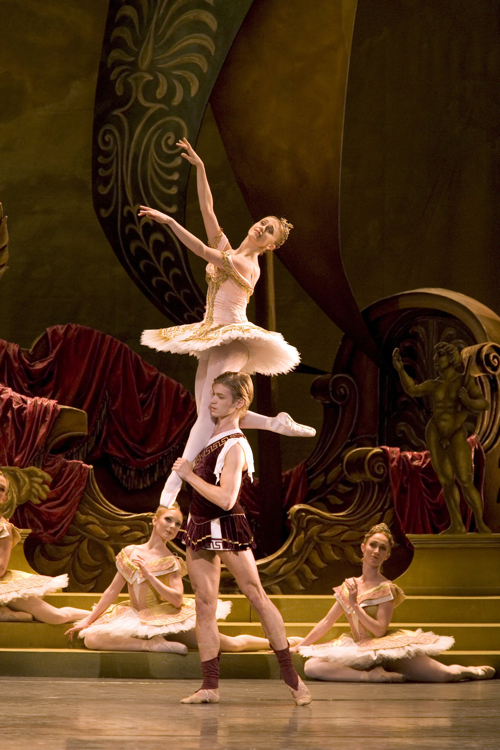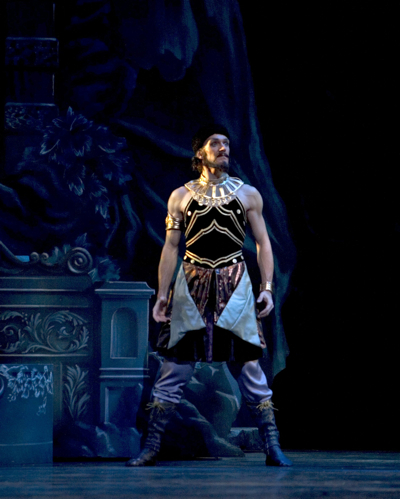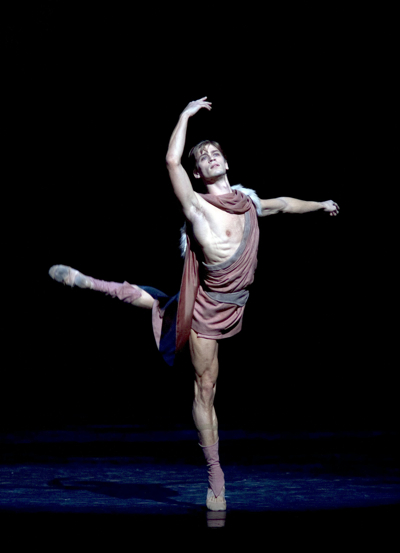Sylvia, Royal Ballet | reviews, news & interviews
Sylvia, Royal Ballet
Sylvia, Royal Ballet
That zany thing, a nymph ballet, gets a bewilderingly bad first night out
Places, please, deliciousness, please. This is Delibes, a man whose music goes with delectable disbelief, and this is that zany thing, a Fifties nymph ballet, so let us sip hallucinogenic Arcadian cocktails and leave normality at the cloakroom. But the sheer prettiness of Léo Delibes's ballets (La Source, Coppélia, Sylvia) is too much for most dancemakers to digest. Even a choreographer so oozing charm as Frederick Ashton made no classic with his 1952 staging of Sylvia. Last night, given the bumbling performance by the Royal Ballet after a few years’ absence, it came over even more as a ballet best to have on iPod.
Satyrs and nymphs are tricky for today’s stolidly educated audiences, who rarely have the faintest idea of the erotic and emotional thrills of tales of half-human, hugely hung goats or semi-divine huntresses who will shoot a man dead sooner than look at him. Handsome, none-too-bright chaps roam through classical myth's deceptive landscapes, inadvertently upsetting naiads and dryads, or being pursued for no fault of their own by deities with a bet to settle. Goddesses forever bound to chastity find their hearts distressingly melting when a shepherd crosses their path.
These are gloriously wild subjects for music theatre, and opera makes maximum capital of them, stringing out moments of self-discovery into heartstopping arias, or conjuring up amusingly fantastical staging. Perhaps because the more capricious passions such as jealousy or romantic cussedness are much harder to convey in gestures without turning into melodrama, in ballet one is left with the age-old plot of girl meets boy, girl disses boy, girl realises her mistake, they get married.
 So it is with Sylvia, a nymph of the bitter feminist goddess Diana, who does her duty by shooting down Aminta, a mooning shepherd admiring her, but little realises that Diana and love-god Eros are having a squabble in which Sylvia and Aminta will be the patsies. Orion, one of the oversexed god-louts who roam Arcady (played of course as a swarthy Turk with big pawing hands), kidnaps Sylvia for his plaything, but Eros, determined to humiliate humourless Diana, fixes it so that Sylvia gives up her chaste calling and has a grand Russian-ballet-style wedding with her shepherd (Act Three pictured right), while Diana has a fit. Not a plot to be probed too deep for Women's Studies, perhaps, but ripe for conspiratorial wits determined to create high-flown, artful entertainment of a balletic kind.
So it is with Sylvia, a nymph of the bitter feminist goddess Diana, who does her duty by shooting down Aminta, a mooning shepherd admiring her, but little realises that Diana and love-god Eros are having a squabble in which Sylvia and Aminta will be the patsies. Orion, one of the oversexed god-louts who roam Arcady (played of course as a swarthy Turk with big pawing hands), kidnaps Sylvia for his plaything, but Eros, determined to humiliate humourless Diana, fixes it so that Sylvia gives up her chaste calling and has a grand Russian-ballet-style wedding with her shepherd (Act Three pictured right), while Diana has a fit. Not a plot to be probed too deep for Women's Studies, perhaps, but ripe for conspiratorial wits determined to create high-flown, artful entertainment of a balletic kind.
The Covent Garden staging pays homage to the Fifties styling by Christopher and Robin Ironside (fascinating essay in the programme by Christopher's daughter, the agony aunt Virginia Ironside), with lashings of Arcadian scenery and props: temples, Erotic bows and arrows, charming huntress helmets, bad Oriental concubines and a florid ship that deserves an alternative life as a cocktail bar. What such an artfully hedonistic theatrical entertainment then needs in performance is gallons of fun-loving finesse and a peach of a ballerina, capable of luring you inescapably into her charisma and glamour, and making you believe every last impossible thing she tells you with her glancing eyes, her beckoning fingers and her exquisite, pawing little toes. Originally it was Margot Fonteyn, the goddess of style and music.
But last night’s performance was given with a deflating absence of care and sheer imaginative effort that once again levels questions at how on earth the Royal Ballet expects to bewitch new generations with ballet’s wonders if they can’t give a convincing impression of loving it themselves. With most ballets, as with jokes, it’s less the substance than the way you tell them. This kind of casualness kills a period-piece like Sylvia stone-dead, dancers dropping constantly out of style when off the ball, as if still in the studio, little regard paid to the refinement of feet and épaulement, and a bewildering lack of engagement with the music.
A fair portion of blame rested with the music-making itself; Delibes’s delights emerged in disarray from instrumentalists not keeping good time or pitch, too much bombast and too little relish. The highlight of Act One, the entrance of the hunting nymphs, is like a potted Ride of the Valkyries, and conductor Boris Gruzin, a Russian from the Mariinsky, whacked the volume setting exhilaratingly for it but failed to counterpoint it with the sensual tendernesses and sweetmeats elsewhere in the score. Act Three, with its party dances for goats and gods, the pizzicato solo for Sylvia and the honeyed violin solo of the pas de deux, was more fun to listen to. Concertmaster Peter Schulmeister’s tone emerged almost shockingly sensual in the rough company elsewhere in the pit.
Marianela Nuñez is a girl blessed with scintillating leg action, glorious flying jumps and a climactic way of throwing herself into the six o’ clock arabesque penché that can make you feel lightning has just struck the earth, yet she neglects the slapdash impression of her arms and the exultant wit that she could bring if she showed more musical interest. She raced the orchestra through her solos, a girl on a mission to get the job done, quite possibly the most efficient nymph in Diana’s establishment. Little chance of believing she would spare passing tenderness for the palely loitering Aminta of Rupert Pennefather (pictured below right), a reticent young man at the best of times who looked positively intimidated most of the time last night.


Better value came from Gary Avis (pictured above left) who always gives good villain, chucking himself into Orion’s jumps as fiercely as he rolls his eyeballs; Laura Morera’s raging Diana and Paul Kay’s nimble Goat also stood out like good deeds in a dullard's world. At the nether end of which, the fruity mugging in Act Two of the two Slaves, Fernando Montaño and Dawid Trzensimiech, and their astonishingly untidy gambols and tambourine-bashing. If a company is going to put on a minor work, I would expect them to focus all their finest persuasive arts on it - they could start with the dancers themselves.
- The Royal Ballet performs Sylvia tonight, Saturday, 9, 10, 12, 15, 19, 26 November and 1 December. Other Sylvias are Lauren Cuthbertson, Sarah Lamb and Zenaida Yanowsky
- See what's on at the Royal Ballet in 2010-11. Read all Royal Ballet reviews on theartsdesk
 Recordings of Delibes's ballets on Amazon: Sylvia/La Source, Coppélia (with Paris Opera Orchestra and Jean-Baptiste Mari/Charles Mackerras)
Recordings of Delibes's ballets on Amazon: Sylvia/La Source, Coppélia (with Paris Opera Orchestra and Jean-Baptiste Mari/Charles Mackerras)
Explore topics
Share this article
Add comment
more Dance
 All You Need Is Death review - a future folk horror classic
Irish folkies seek a cursed ancient song in Paul Duane's impressive fiction debut
All You Need Is Death review - a future folk horror classic
Irish folkies seek a cursed ancient song in Paul Duane's impressive fiction debut
 MacMillan Celebrated, Royal Ballet review - out of mothballs, three vintage works to marvel at
Less-known pieces spanning the career of a great choreographer underline his greatness
MacMillan Celebrated, Royal Ballet review - out of mothballs, three vintage works to marvel at
Less-known pieces spanning the career of a great choreographer underline his greatness
 Carmen, English National Ballet review - lots of energy, even violence, but nothing new to say
Johan Inger's take on Carmen tries but fails to make a point about male violence
Carmen, English National Ballet review - lots of energy, even violence, but nothing new to say
Johan Inger's take on Carmen tries but fails to make a point about male violence
 WAKE, National Stadium, Dublin review - a rainbow river of dance, song, and so much else
THISISPOPBABY serves up a joyous tapestry of Ireland contemporary and traditional
WAKE, National Stadium, Dublin review - a rainbow river of dance, song, and so much else
THISISPOPBABY serves up a joyous tapestry of Ireland contemporary and traditional
 Swan Lake, Royal Ballet review - grand, eloquent, superb
Liam Scarlett's fine refashioning returns for a third season, and looks better than ever
Swan Lake, Royal Ballet review - grand, eloquent, superb
Liam Scarlett's fine refashioning returns for a third season, and looks better than ever
 First Person: Ten Years On - Flamenco guitarist Paco Peña pays tribute to his friend, the late, great Paco de Lucía
On the 10th anniversary of his death, memories of the prodigious musician who broadened the reach of flamenco into jazz and beyond
First Person: Ten Years On - Flamenco guitarist Paco Peña pays tribute to his friend, the late, great Paco de Lucía
On the 10th anniversary of his death, memories of the prodigious musician who broadened the reach of flamenco into jazz and beyond
 Dance for Ukraine Gala, London Palladium review - a second rich helping of international dancers
Ivan Putrov's latest gala was a satisfying mix of stars and young hopefuls
Dance for Ukraine Gala, London Palladium review - a second rich helping of international dancers
Ivan Putrov's latest gala was a satisfying mix of stars and young hopefuls
 Nelken: A Piece by Pina Bausch, Sadler's Wells review - welcome return for an indelible classic
A new generation of gifted performers for us to get to know
Nelken: A Piece by Pina Bausch, Sadler's Wells review - welcome return for an indelible classic
A new generation of gifted performers for us to get to know
 Dark With Excessive Bright, Royal Ballet review - a close encounter with dancers stripped bare
The Royal's Festival of New Choreography launches with an unforgettable walk in the dark
Dark With Excessive Bright, Royal Ballet review - a close encounter with dancers stripped bare
The Royal's Festival of New Choreography launches with an unforgettable walk in the dark
 La Strada, Sadler's Wells review - a long and bumpy road
Even the exceptional talents of Alina Cojocaru can't save dance adaptation of Fellini film
La Strada, Sadler's Wells review - a long and bumpy road
Even the exceptional talents of Alina Cojocaru can't save dance adaptation of Fellini film
 First Person: pioneering juggler Sean Gandini reflects on how the spirit of Pina Bausch has infiltrated his work
As Tanztheater Wuppertal Pina Bausch's 'Nelken' comes to Sadler’s Wells, a tribute from across the art forms
First Person: pioneering juggler Sean Gandini reflects on how the spirit of Pina Bausch has infiltrated his work
As Tanztheater Wuppertal Pina Bausch's 'Nelken' comes to Sadler’s Wells, a tribute from across the art forms
 Manon, Royal Ballet review - a glorious half-century revival of a modern classic
Fifty years on, Kenneth MacMillan's crash-and-burn anti-heroine is riding high
Manon, Royal Ballet review - a glorious half-century revival of a modern classic
Fifty years on, Kenneth MacMillan's crash-and-burn anti-heroine is riding high

Comments
...
...
...